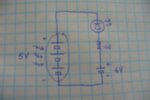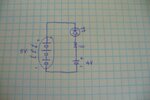Externet
Advanced Member level 2
- Joined
- Jan 29, 2004
- Messages
- 579
- Helped
- 28
- Reputation
- 58
- Reaction score
- 29
- Trophy points
- 1,308
- Location
- Mideast US
- Activity points
- 5,666
Hi.
A Lithium cell fully charged at 4V, placed on a circuit as attached, with a (small) 5V solar panel with 10 cells, in darkness, without blocking diode.
What current to expect ?
Will the cell discharge only to the white LED Vf value ?
What Vr presents a solar panel ?
Will the LED shine ?
A Lithium cell fully charged at 4V, placed on a circuit as attached, with a (small) 5V solar panel with 10 cells, in darkness, without blocking diode.
What current to expect ?
Will the cell discharge only to the white LED Vf value ?
What Vr presents a solar panel ?
Will the LED shine ?

